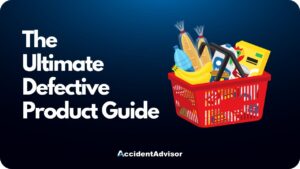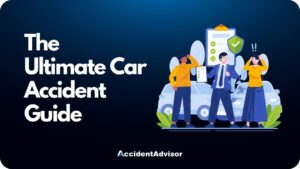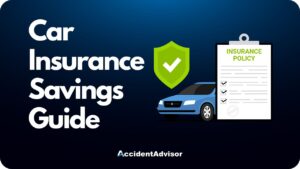Determining who is at fault in a rear-end collision involving 3 cars can be tricky. In many cases, drivers assume that whoever was in the back is at fault for the collision, but this is not always true.
Multiple parties could be the answer to the question of who is at fault in a rear-end collision involving 3 cars. Due to the complexity of the situation, in my experience, an attorney in your area with a history of negotiating multi-car collision cases is your best source of information for learning more about your situation.
Table of Contents
- What Is a Multiple Car Accident?
- Common Causes of 3 Car Accidents
- Types of Crashes that Involve Multiple Vehicles
- Determining Liability After a 3 Car Rear-End Collision
- Evidence to Determine Multi-Car Accident Liability
- How Does Insurance Work in a 3 Car Rear-End Collision?
- How Long Do You Have to Make a Claim?
- A Lawyer Can Sort Out the Liability Questions for You
What Is a Multiple Car Accident?
When more than two vehicles are involved in one crash, it’s called a multiple-car accident. Regardless of whether 3, 4, or 10 vehicles are involved, and regardless of whether they are trucks, motorcycles, or anything else with wheels, all these accidents qualify.
Multiple-car accidents often happen at intersections where multiple cars cross paths. Typically, multiple-car accidents account for around 9% of all vehicle crashes (about 8,000 crashes per year). Yet, they account for around 18% of all motorists who die on the road.
In 2021, the NHTSA reported a 15% increase in fatal crashes involving multiple vehicles, compared to a 10% increase overall. In my experience, multi-car accidents are the most dangerous to experience as well as some of the most complicated to settle, in part due to the high rate of fatalities.
Common Causes of 3 Car Accidents
To discuss the question of who is at fault in a rear-end collision involving 3 cars, these common causes of 3 car accidents should be understood:
Alcohol: As with any crash, drunk driving accounts for around 30% of fatalities in multi-car crashes.
Poor weather: Poor weather causes over a million crashes every year by reducing visibility and changing the surface of the road.
Recklessness: Reckless drivers, especially when visibility is poor, are common causes of multi-car accidents. In my experience, distracted drivers, even if just by a phone, can often be just as dangerous as reckless ones.
Tailgating: Driving too close to the car in front often causes multi-car accidents involving at least one rear-end collision.
Types of Crashes that Involve Multiple Vehicles
Crashes involving 3 vehicles could be one of several types, including rear-end collisions, head-on collisions, or t-bone collisions.
In rear-end collisions, multiple cars crash into each other from behind. In head-on collisions, multiple cars crash into each other from the front. In t-bone collisions, which often happen at intersections, a vehicle crashes into the side of another vehicle.
In multi-car accidents, multiple types of accidents often happen at the same time due to the road obstruction caused by the pileup of multiple cars.
Determining Liability After a 3 Car Rear-End Collision
Liability can be difficult to determine in a 3 car rear-end collision, though in most cases the fault rests with the driver who was driving behind the front car. In other words, the first car to crash is at fault for the other accidents. However, this is not always the case.
For example, the driver in the front could slam their brakes unexpectedly, be driving under the influence of alcohol, or be driving distracted. If that driver fails to give the cars in the back a reasonable chance to brake before crashing, they may be at fault for the accident instead.
When the Car in Front Can Be Liable for a Three-Car Rear-End Collision
In my experience, the car in front is the least likely to be deemed at fault for a multi-car accident, but this can happen if they brake irresponsibly. If they slam to a stop to avoid an animal, for instance, they may be at fault for causing the cars behind them to crash into them.
When the Middle Car Can Be At-Fault for a Three-Car Rear-End Collision
The middle driver is most often at fault in a rear-end collision involving 3 cars. All they have to do to cause a crash is look down and not realize the car in front of them has started braking.
When the Back Car Can Be Responsible for a Three-Car Rear-End Collision
The back car could be to blame for the accident if they are driving distracted or tailgating the car in front of them. By doing so, they don’t give themselves a chance to stop in time.
When a Third Party Can Be Liable for a Three-Car Rear-End Collision
I have seen many cases involving a multi-car accident where a third party was deemed liable for the crash. Irresponsible behavior by a pedestrian, an accident with work equipment on the road, or a faulty piece of machinery in any of the vehicles are just a few examples of how, in some cases, none of the drivers are at fault.
Evidence to Determine Multi-Car Accident Liability
To determine multi-car accident liability, there are many types of relevant evidence, including:
- Photos from the scene
- Witness testimonies
- Doctor’s notes
- Police report
- Camera footage
- Toxicology report
You can gather some of this evidence yourself while other types will be assembled by the authorities. Make sure you get a copy of every piece of relevant evidence for your case.
How Does Insurance Work in a 3 Car Rear-End Collision?
Insurance works differently in multi-car accidents depending on state laws regarding personal injury protection (PIP). Some states require all drivers to have a certain amount while others leave it up to the drivers.
Depending on the coverage of each driver, the insurance companies will negotiate compensation differently. If one of the drivers lacks sufficient coverage, for instance, the other drivers’ uninsured/underinsured motorist coverage will have to make up the difference.
In the multi-car accident cases I’ve seen, the most complicated for the insurance companies to settle are those that involve a third party. Consider that if faulty stoplights are to blame, the victims may even try to sue the city for negligence, raising the profile of the case considerably.
How Long Do You Have to Make a Claim?
The statute of limitations in your state determines how long you have to make a claim after your accident. The statute in most states lasts between 2 and 4 years after the crash, though some can be as short as 1 year or as long as 6 years.
Keeping track of the statute of limitations is key to successfully filing for compensation for your accident. The insurance company will not be obligated to cover your injuries if you file too late.
A Lawyer Can Sort Out the Liability Questions for You
When trying to decide who is at fault in a rear-end collision involving 3 cars, you’ll be up against 2 or more insurance companies, your own insurers, and any third parties that have gotten involved. This is why multi-car accident cases take longer to settle than other types of accidents.
This is why, even more so than in other car accidents, victims need the counsel of an experienced car accident attorney in their state to help them navigate the complex process of gathering evidence, filing for compensation, and determining fault in a case involving 3 or more drivers.

Rocky Horton
Author
Rocky Horton is a health and safety expert from Chapel Hill, NC. He is the founder of AccidentAdvisor and has been featured in Forbes, Bloomberg, and other publications. Learn more.













